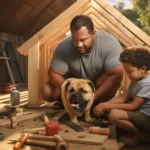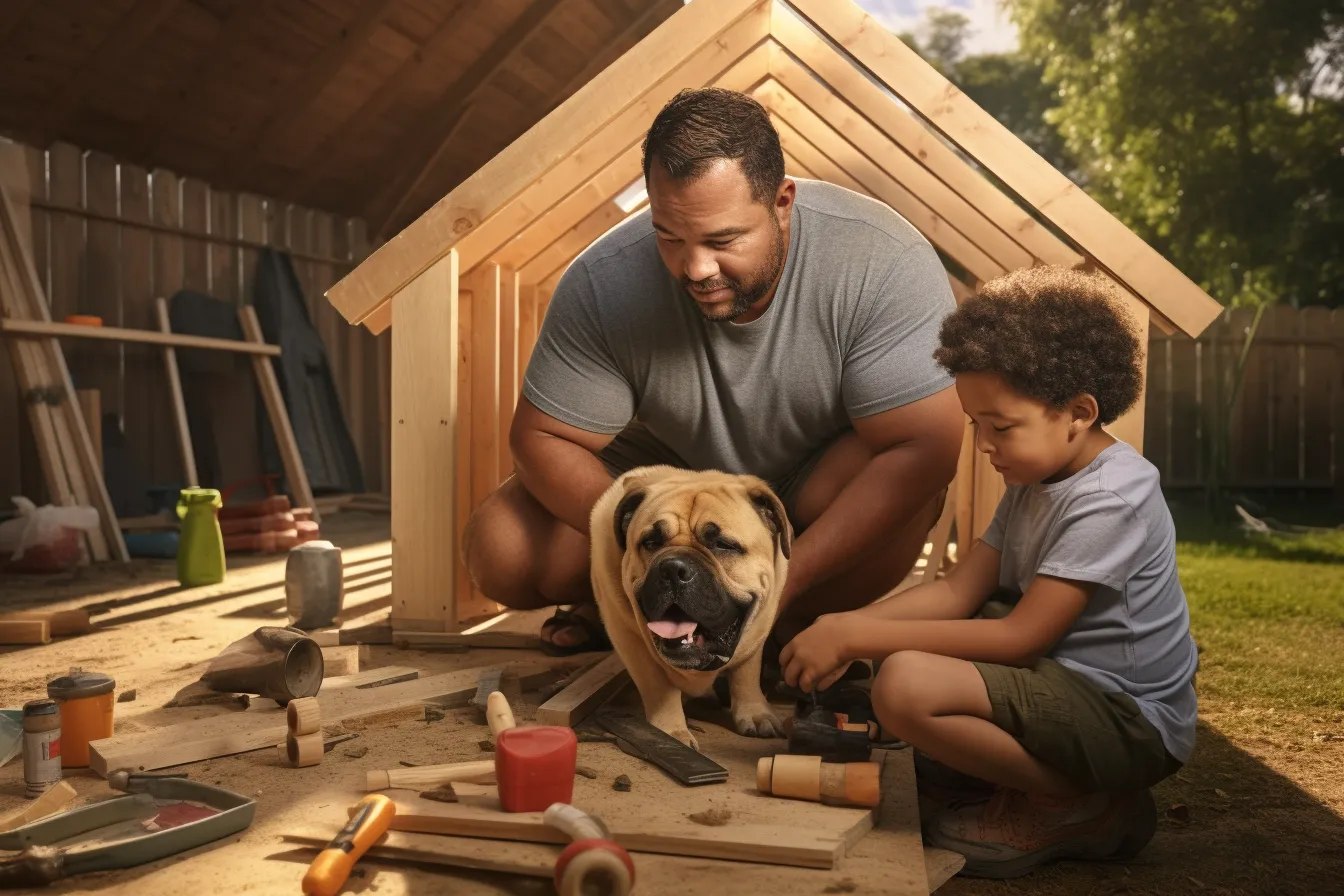How to build a simple dog house can be an enjoyable and rewarding DIY project for you and the whole family or a thoughtful gift for a friend. The best part is that you don’t need advanced woodworking skills or expensive materials to create a comfortable and stylish shelter for your furry friend.
With a variety of styles, from traditional slanted designs to modern insulated houses, there’s a perfect option for every preference and canine companion. Plus, you can customize your dog house by adding a personal touch, such as a front porch for food dishes or a removable roof for easy cleaning. In this step-by-step guide, I’ll walk you through the process of constructing a basic dog shelter using a few simple tools and affordable materials like wood, roofing sheets, and nails.
Key Takeaways
- Create a cozy and safe space tailored to your dog’s preferences, from open designs to insulated shelters.
- Consider the location and size of your dog house, ensuring it’s both comfortable and functional for your pet.
- Use affordable materials and basic tools to construct a durable dog house that will stand the test of time.
- Add unique and personal touches to make your dog house stand out and cater to your pet’s needs.
- Follow a step-by-step dog house construction tutorial to ensure successful completion and a sturdy end result.
Understanding Your Dog’s Needs Before Building a Shelter
To build the best shelter for your pet, it is crucial to understand your dog’s preferences and habits. A well-planned dog house building guide should take into consideration factors such as your pet’s size, temperament, and specific needs regarding climate control and insulation.
Affordable dog house construction doesn’t mean sacrificing your pet’s comfort or safety. Remember, your dog’s happiness should be the primary driver of your design choices. In this section, we will cover three vital aspects to consider before starting the building process:
- Dog’s temperament and preferences
- Climate control needs
- Insulation requirements
“A dog is the only thing on earth that loves you more than he loves himself.”
– Josh Billings
Dog’s Temperament and Preferences
Before diving into easy dog house building tips, consider your furry friend’s personality. Some dogs may appreciate an open design without walls, while others might need a cozy, enclosed space. Experiment with temporary arrangements to see what makes your dog the most comfortable.
Climate Control Needs
The weather in your area plays a significant role in defining the optimal dog house design. If you live in a place with extreme temperature fluctuations, a well-insulated dog house is essential. On the other hand, if you reside in a relatively stable climate, ventilation and shade might be more critical than insulation.
Insulation Requirements
Ensuring your dog has adequate insulation in its shelter can lead to a happier and healthier pet. The insulation not only keeps your dog warm in the winter but also cool in the summer. Thus, it’s essential to keep the insulation requirements in mind when planning your affordable dog house construction project.
| Temperament | Climate Control Needs | Insulation Requirements |
|---|---|---|
| Open-design Loving | Mild, stable climate | Low insulation |
| Cozy-seeking | Extreme temperature fluctuations | High insulation |
Remember, a customized dog house building guide should always account for your pet’s unique needs. Now that you have a better understanding of your dog’s preferences and requirements, you’re well-prepared to embark on your dog house construction journey.
Choosing the Right Location and Size
When it comes to building your dog’s perfect haven, location and size are critical factors. The dog house should provide comfort and protection, considering factors like climate conditions and your pet’s habits. In this section, we’ll discuss how to select the optimal site for your pet’s safety and well-being, as well as how to determine the ideal size for your pet’s home.
Selecting a Site for Comfort and Protection
Finding the right location for your dog’s house can significantly impact their comfort and sense of security. A well-chosen spot should be dry and provide shelter from winds, ensuring your pet feels safe and at ease. Consider the following when selecting a location:
- Choose an area that is not prone to flooding or excessive moisture.
- Avoid spaces with excessive direct sunlight, as it can make the dog house too hot for your pet.
- Place the dog house in a position that is shielded from prevailing winds.
- Ensure the site is level for stability and ease of construction.
- If possible, opt for an area that offers some natural shade for added comfort during hot weather.
Determining the Perfect Size for Your Pet
It is essential to build a dog house that is appropriately sized for your dog’s comfort and safety. The space should be large enough for your dog to sit up, lie down, and turn around comfortably but small enough to help retain body heat for warmth. Keep the following pointers in mind when determining the ideal size for your pet’s house:
- Measure your dog’s height and length while standing, as well as their height at rest.
- Provide enough space for your pet to move around comfortably, but not so much that it loses heat quickly in colder climates.
- Consider the size variance depending on your pet’s breed and adjust the dimensions accordingly.
- Ensure the house has a height clearance slightly taller than your pet’s height to allow for comfortable entry and exit.
In conclusion, choosing the right location and size for your dog house is vital to ensure your pet’s comfort and protection. A well-situated and appropriately sized house built using the best materials for dog houses, following a reliable dog house building guide, and applying step-by-step dog house construction strategies along with easy dog house building tips will provide your pet a cozy, safe space they can call their own.
Gathering Materials: What You’ll Need
Building a small dog house with basic tools can be a satisfying and cost-effective project. Before diving into constructing a basic dog shelter, it’s essential to have a clear DIY dog house plan and gather all the necessary materials. Create a checklist to make sure you have everything you need in advance.
Remember, safety first! Wear proper protective gear, such as gloves and protective eyewear, when using tools and handling raw materials.
- Wood: One of the most critical elements is the wood for the framework and walls. Consider using exterior plywood or untreated lumber for a budget-friendly option.
- Screws and nails: To hold everything together, you’ll need screws and nails of varying lengths, such as 1½” and 2½” wood screws, and 16-gauge galvanized nails.
- Roofing materials: Roofing materials like asphalt shingles or metal sheets will protect your dog from the elements and provide added durability.
- Paint or wood stain: Choose a paint or wood stain that complements the surroundings and provides extra protection against the weather.
- Tools: Make sure you have a handsaw or jigsaw, a drill, a hammer, a tape measure, a carpenter’s square, and a level to ensure a precise and secure assembly.
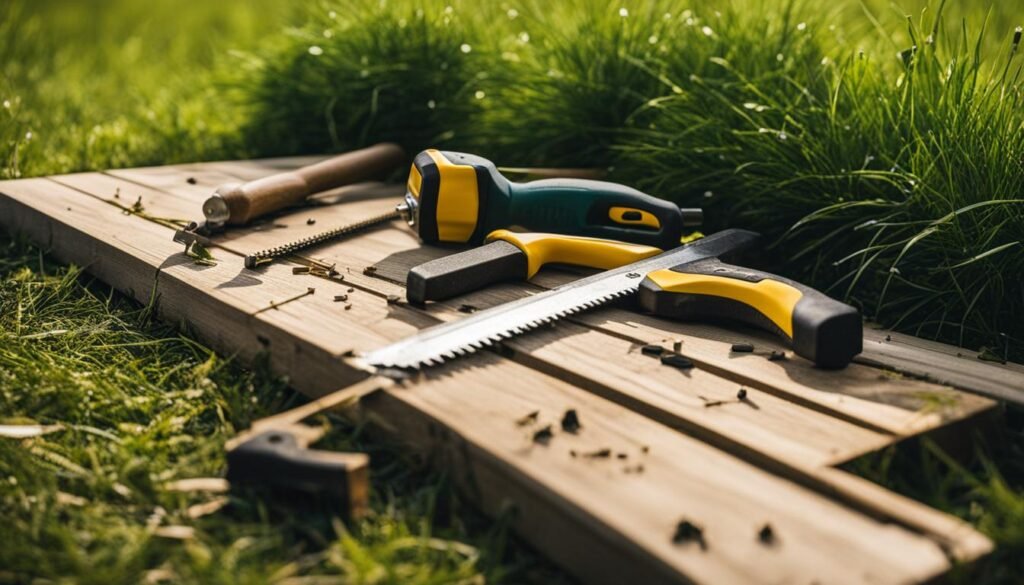
Economic material options are available and can even be sourced from scraps or recycled materials for cost efficiency. Consider checking with local construction sites, hardware stores, or online marketplaces for used or surplus materials at a bargain.
| Economical Material Options | Potential Sources |
|---|---|
| Repurposed wooden pallets | Retailers, warehouses, factories |
| Leftover plywood sheets | Construction sites, woodworking shops |
| Discarded metal sheets | Metal fabrication businesses, recycling centers |
| Used paint or wood stain | Local hardware store, neighbors or friends |
Beyond the basic necessities, think about personalized features that cater to your furry friend’s specific needs and preferences. Chew toys, a removable ramp for easy access, or a toy storage compartment can make the dog house truly shine.
Setting the Foundation: how to build a simple dog house A Step-by-Step Guide
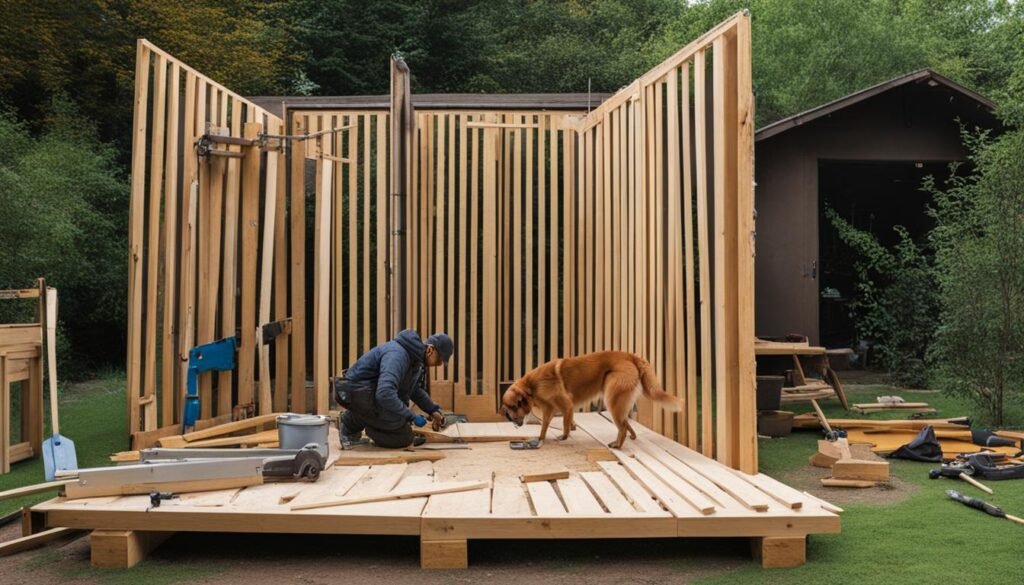
Before diving into the actual dog house construction, it’s crucial to establish a strong and level foundation. A proper base ensures that the dog shelter remains sturdy and avoids any potential structural issues down the line. In this section, we will walk you through a simple dog house construction tutorial that lays the groundwork for your pet’s new home.
Preparation and Layout Considerations
Finding the perfect location for your dog house is just as important as the construction itself. To ensure your dog’s comfort and safety, consider the following factors:
- Examine the ground level and water drainage in the area where you plan to place the dog house. Ideally, the site should be relatively flat and elevated to prevent water from seeping into the structure.
- Ensure that the foundation is sturdy and level by using pressure-treated lumber for ground contact. This material helps prevent rot and extends the life of the wooden structure.
- Take into account the size and shape of the dog house to ensure that the foundation layout provides enough space for walls, roof, and entryway.
- Check for any potential hazards nearby, such as tree branches or structures that could fall onto the dog house, and remove them if needed.
Now that you have considered the essential aspects of the foundation layout, let’s move on to constructing the base.
“A sturdy foundation is the first critical step for any dog house construction.”
To guide you through the step-by-step dog house construction process, follow these steps:
- Begin by leveling the ground where you plan to set the dog house foundation. You can use a shovel, rake, or similar tools to evenly distribute the soil and create a flat surface.
- Place pressure-treated lumber in the desired layout for your dog house foundation, ensuring that all corners form right angles and edges are perfectly aligned.
- Securely fasten the lumber corners with galvanized screws, nails, or brackets. This step is essential in preventing the base from shifting or collapsing.
- Double-check the final foundation setup to ensure that it is level and square, making adjustments if needed.
By following this simple dog house construction tutorial, you can now confidently move on to the next step of constructing a basic dog shelter – building the frame.
Constructing the Frame: Assembling Walls and Roof
After gathering the required materials and tools, it’s time to start constructing your dog’s new home. In this simple dog house construction tutorial, I will explain how to assemble the walls and construct a sturdy roof to ensure your dog has a secure and comfortable shelter.
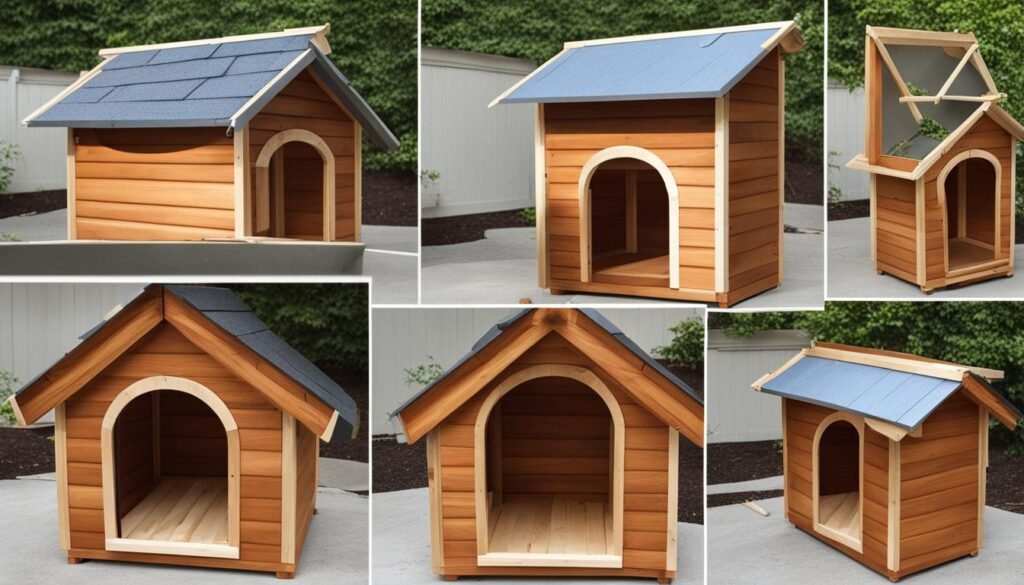
Follow these step-by-step dog house construction guidelines to assemble the walls:
- Begin by cutting the wooden boards according to your dog house design and measurements, ensuring all pieces are accurate in size and shape.
- Position the front and back walls, aligning them on the base and securing them in place with screws. Be sure all edges are flush and that there are no gaps between the boards.
- Attach the side walls to the front and back walls using screws, ensuring a tight fit.
- For added stability and weather resistance, apply a bead of sealant along all seams and corners where the walls meet.
Moving on to the roof construction, here are the steps to follow:
- Select a roof design that provides adequate protection and ventilation, such as a sloping gable roof, a flat roof, or a slanted single-pitched roof.
- Measure and cut the necessary wooden boards and roofing material, such as plywood and shingles, to fit your chosen roof design.
- Attach the roof structure’s frame to the walls using screws, making sure it is secure and stable.
- Cover the frame with the roofing material, nailing down shingles or screwing down roofing sheets to ensure a watertight seal.
By following these steps, you can successfully construct a basic dog shelter that is both attractive and functional. However, there are many ways to personalize and improve your dog’s new home, such as adding insulation, painting the exterior, or adding a small porch for outdoor lounging. The possibilities are endless, allowing you to build a unique and comfortable space for your furry friend to enjoy.
Roofing and Insulation Tips for a Cozy Canine Home

Creating a cozy canine home involves making the right decisions regarding roofing and insulation. This helps to keep your dog comfortable and protected, regardless of the weather outside. In this section, we will discuss the best materials for dog houses and how to ensure proper insulation.
Best Materials for Dog Houses
Choosing the best materials for your dog house ensures durability and comfort for your pet. Consider the following:
- Exterior plywood: weather-resistant and affordable, this material provides a sturdy and lasting structure for your dog house.
- Roofing tacks and liquid nails: These help to attach the roofing material securely to the plywood structure, ensuring your dog stays dry during wet weather.
- Insulated A-frame roofs: These offer added warmth and insulation, perfect for cooler climates.
Aside from the structural materials, consider adding personalized features such as sun decks or cosmetic touches to enhance the overall appearance of your dog’s cozy home.
Ensuring Proper Insulation
Providing adequate insulation is crucial to maintaining a warm shelter for your dog during the cold months. To achieve this, keep the following tips in mind:
- Choose well-insulated designs: Seek dog house building guides that prioritize insulation and provide step-by-step dog house construction instructions for proper insulation.
- Use additional heating aids: Heat lamps can be installed to enhance warmth within the dog house, making sure to take necessary safety precautions.
- Seal any gaps: Small openings can lower the effectiveness of insulation. Inspect the structure for any gaps and seal them accordingly.
By using the best materials and ensuring proper insulation, your dog house will become a cozy canine home. Keep these tips in mind while following the dog house building guide and constructing your pet’s warm and safe retreat.
Adding Personal Touches: Customization Ideas
Creating a unique and personalized dog house is a fun way to showcase your creativity and cater to your pet’s needs. Explore various options to make the dog shelter not only functional and comfortable but also a reflection of your pet’s personality. Below is a list of some customization ideas for your custom dog house plans:
- A porch for placing food dishes and making it a convenient dining area for your pet
- A lean-to or partially open house design for dogs that prefer open spaces
- Reconfigurable designs that offer flexibility in accordance with your dog’s changing needs and preferences
- Automation features for climate control, such as a heater or fan, ensure optimal comfort
- Aesthetic touches like unique color schemes or patterns make the dog house a statement piece in your yard
Another way to make your pet’s shelter unique is by experimenting with various materials and textures. For instance, instead of using conventional wood, you can opt for weather-resistant and low-maintenance materials like vinyl or PVC. Incorporating recycled materials can also add to the uniqueness and eco-friendliness of the project.
It is essential to consider your dog’s needs and personal preferences when adding personal touches to dog houses. For instance, some dogs may feel more at ease in shelters offering clear access points or close to the main house. On the other hand, others might appreciate a secluded spot with dense foliage providing shade and privacy.
Designing a dog house is an excellent opportunity to express your love for your furry friend and provide them a safe haven that caters to their preferences.
If you are looking for inspiration and more ideas on unique dog shelter designs, social media platforms like Pinterest, Instagram, or dedicated pet blogs can help. You can draw inspiration from a variety of projects, ranging from the simplest to the most elaborate designs that can be customized to match your pet’s disposition and your landscape.
Ultimately, the goal is to create a shelter that brings joy and comfort to your dog. Hence, investing time and effort in adding personal touches and customizations will ensure that your pet feels secure and content in their new home.
Conclusion
Building a simple dog house can be a fun and rewarding DIY project, providing your beloved pet with a cozy and functional sanctuary. By considering your dog’s needs, preferences, and habits, you can ensure that you create a shelter that is perfectly suited to their comfort and enjoyment. With DIY dog house plans and step-by-step dog house construction methods, you can build a small dog house with basic tools and materials, making the process accessible for DIY enthusiasts of all skill levels.
When constructing a basic dog shelter, it’s essential to choose the right location and size, as well as appropriate building materials that will withstand the elements and provide a safe haven for your furry friend. With easy dog house-building tips, you can make adjustments and modifications that will enhance the overall value and allure of your pet’s new home.
Don’t forget to add personal touches and customizations that will truly make the dog house stand out and reflect your unique style. Whether it’s a custom paint job, a charming front porch, or a sun deck, these additional elements can help make your dog’s new home a special place for them to rest and retreat. In the end, the satisfaction of completing this creative project and the joy it brings to your pet will make all the time and effort worthwhile.
FAQ
What are the basic materials and tools needed to build a simple dog house?
Basic materials include wood, screws, roofing materials, and nails. The tools needed are a saw, drill, hammer, and tape measure. For a cost-efficient option, consider using scrap or recycled materials for parts of the structure.
How can I determine the right size for my dog’s house?
Ensure the space is large enough for your dog to comfortably sit, lie down, and turn around, but small enough to help retain body heat for warmth. Take note of your dog’s breed and size when adjusting the dimensions of the dog house. Measure your dog before starting the project to ensure a proper fit.
What should I consider when choosing a location for the dog house?
Consider climate conditions, including sun exposure and wind direction, as well as your dog’s habits and preferences. Place the dog house in a dry area that provides shelter from strong winds, ideally in a spot where your dog already likes to spend time.
What materials should I use for roofing and insulation?
Exterior plywood, roofing tacks, and liquid nails are suitable for the outer structure. Insulated A-frame houses offer extra warmth for colder climates. Ensure proper insulation by sealing in gaps, using additional materials like foamed-in-place insulation, or adding heat lamps with appropriate safety precautions.
How can I personalize my dog’s house and make it unique?
Add personal touches with design elements such as a porch for food dishes, a lean-to structure for dogs that prefer open spaces, or reconfigurable panels for flexibility. Implement decorative shingles, paint, or add automation features for climate control. Use your creativity to craft a statement piece that reflects your dog’s personality and style.




